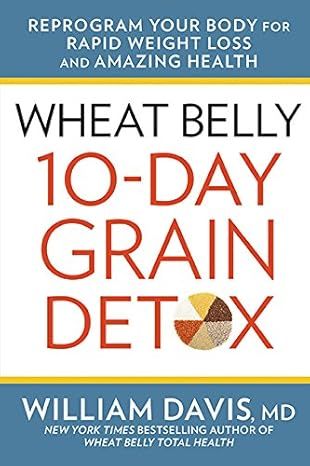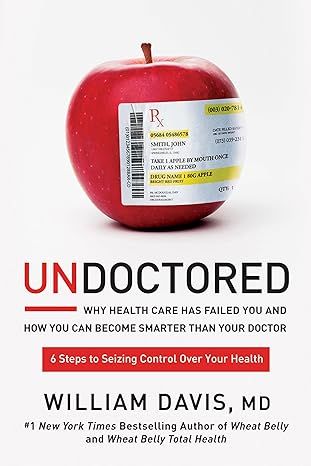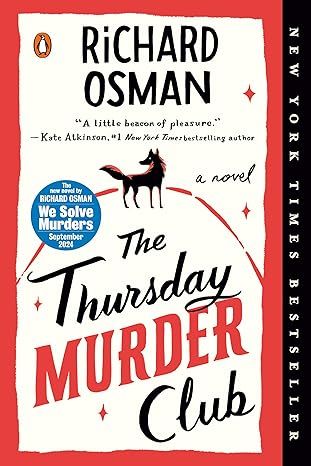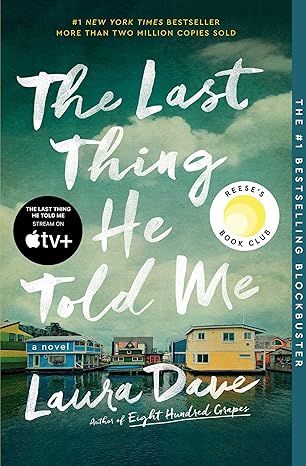Wheat Belly 30-Minute (Or Less!) Cookbook: 200 Quick and Simple Recipes to Lose the Wheat, Lose the Weight, and Find Your Path Back to Health
4.4
-
2,446 ratings
200 gluten-free recipes to help you lose weight while following the Wheat Belly diet.
Wheat Belly shook the foundations of the diet world when author and renowned cardiologist William Davis revealed that an epidemic of adverse health effects—from mysterious rashes and high blood sugar to stubborn belly fat (so-called "wheat bellies")—could be banished forever with one simple step: Saying goodbye to wheat. The Wheat Belly Cookbook built on that foundation with hundreds of delicious, family favorite recipes with a wheat-free makeover.
Now, with Wheat Belly 30-Minute (Or Less!) Cookbook, it's easier than ever with this collection of yummy recipes that are quick enough for busy weekdays—and good enough for company. You will find an introduction to the ABCs of wheat-free cooking, plus a guide to prepping the kitchen, stocking the pantry, and getting started on a healthy new path. Beautifully illustrated with full-color photo inserts, you will enjoy these delicious recipes for breakfast, lunch, dinner, side dishes, snacks, desserts—and even special occasions.
Kindle
$8.99
Available instantly
Hardcover
$15.71
Ships from
Amazon.com
Payment
Secure transaction
ISBN-10
1623362083
ISBN-13
978-1623362089
Print length
272 pages
Language
English
Publisher
Rodale Books
Publication date
December 23, 2013
Dimensions
7.6 x 1 x 9.4 inches
Item weight
1.52 pounds
Product details
ASIN :
B00DVF15GO
File size :
11622 KB
Text-to-speech :
Enabled
Screen reader :
Supported
Enhanced typesetting :
Enabled
X-Ray :
Enabled
Word wise :
Enabled
Editorial reviews
Amazon.com Review
A Look Inside Wheat Belly 30-Minute (Or Less!) CookbookChocolate Smoothie and Muffin recipesBreakfast Cheesecake recipeMacadamia Nut Fudge recipeBrussels Sprouts Gratin recipe
Review
“Renowned cardiologist and New York Times bestselling author, William Davis (Wheat Belly) invites readers to welcome the New Year with 200 quick and guiltless wheat-free recipes. 'Lose the wheat, lose the weight, and find your path back to health' with this new tasty, nutritious and wheatless cookbook. Beautiful photographs accompanied by comprehensive recipes and nutritional information make it easier than ever to eat wheat-free. Delectable recipes for a variety of tastes, meals and occasions include Brussels sprouts gratin, Cajun turkey burgers, key lime cupcakes, eggplant caprese stacks, ginger sesame pepper steak, strawberry and coconut biscuits and cognac truffles. These satisfying and delicious dishes can conveniently all be prepared in 30 minutes or less. In addition to including recipes for breakfast, lunch, dinner, side dishes, snacks, and desserts, the book also includes a guide to prepping a wheat-free kitchen, a sample 14-day menu, plus numerous menu plans for special occasions. Davis provides readers with a health conscious, user-friendly, and wheat-free companion. This collection of fulfilling and healthy wheat-free recipes can become the staple cookbook for any busy and healthy household.” —Publisher's Weekly
About the Author
WILLIAM DAVIS, MD, is a New York Times bestselling author and a cardiologist who advocates unique, insightful, and cutting-edge strategies to help individuals discover the health hidden within them. His blog has been visited by millions of people. Dr. Davis has also shared his passion for wheat-free living on national television shows including The Dr. Oz Show and CBS This Morning. His Wheat Belly Total Health program has become a public television special, now airing nationwide. He lives in Wisconsin.
Read more
Sample
Excerpt. © Reprinted by permission. All rights reserved.
PUTTING TOGETHER YOUR WHEAT-FREE KITCHEN
Start your new wheat-free adventure by purging your shelves of all wheat and wheat-containing products. This is necessary to reduce the temptation to eat those chocolate-covered pretzels you've been saving and other goodies that can—even as the tiniest morsel—undo everything you've accomplished. It also minimizes the potential for future reexposures that can result in anything from gastrointestinal distress (bloating, cramps, diarrhea) to joint pain, asthma, and even emotional effects.
Next, you will need to do some shopping for wheat-free replacement ingredients. Your wheat-free life, for instance, will require some new flours to allow you to create sandwiches, cookies, and other baked goods using healthy nonwheat ingredients. And, for efficiency, especially to create dishes in a 30-minute timeline, a few new kitchen tools will be helpful. All in all, converting your kitchen to one that dispenses wonderfully healthy, tasty, and quick wheat-free dishes really just requires some adjustments to your previous wheat-filled life.
This book serves as a guide for everyone who wishes to eliminate wheat and gluten from their lives. Wheat elimination is not just for the celiac sufferer or the gluten-sensitive; it's for everyone. However, the advice and recipes here are indeed appropriate for the celiac sufferer and gluten- sensitive, though additional efforts will need to be made to accomplish meticulous gluten avoidance, especially looking for "gluten-free" on the label to avoid potential for cross-contamination.
But, before I get started on what you need to conduct your new life of wheatlessness, you first should...
Clean Your Kitchen!
Remember: Wheat products contain gliadin, which degrades in the gastrointestinal tract to a collection of opiates that bind to the opiate receptors of the brain. They don't cause euphoria or pain relief; they trigger appetite. Freeing yourself from the relentless appetite-stimulating effects of wheat, the frequent and intrusive thoughts of food, and the increased but unnecessary calorie intake all add up to a powerful way to control impulse, weight, and health.
Start by clearing your pantry of obvious wheat sources, such as bread, muffins, bagels, pitas, rolls, cookies, energy bars, and pastries. Don't forget the bag of wheat flour too: You will never need it.
After clearing the obvious wheat sources, clear the not-so-obvious sources. Examine the labels of all processed foods to see whether wheat in any form is found on the list of ingredients. See "Wheat ... by Any Other Name!" on page 13 for a list of hidden sources of wheat—yes, it's long!
Common processed foods that contain wheat include:
• Bread crumbs, panko • Breakfast cereals • Canned soups • Cookies • Crackers • Frozen dinners • Frozen waffles and pancakes • Granola bars • Ice cream, frozen yogurt (cookie dough, cookies and cream) • Instant soup mixes • Macaroni and cheese mix • Pancake mix • Pastas • Powdered soup mixes • Pretzels • Salad dressings—bottled and dry mixes • Sauce mixes • Sausages, processed meats • Seasoning mixes • Soy sauce, teriyaki sauce • Twizzlers and other candies
Get rid of it all! Remember: The gliadin protein of wheat is powerfully addictive and will pull you back into its clutches. Don't let that happen!
Restocking the Shelves with Healthy Wheat-Free Foods
Once you've banished all wheat-containing foods from your kitchen, it will be time to restock with healthy replacements. Here are some basic ground rules to follow.
• Read labels. Look for "wheat," "wheat flour," "gluten," "vital wheat gluten," "modified food starch," "caramel coloring," or any of the other dozens of buzzwords for concealed wheat that manufacturers slip in. Refer to "Wheat ... by Any Other Name!" on page 13 if you're unsure about a product. People with celiac disease and gluten sensitivity definitely need to do this, but this is also a good practice for everyone to minimize exposure, and especially to avoid the gastrointestinal and appetite- stimulating effects of wheat.
• Buy single-ingredient natural foods found in the produce aisle, from the butcher, and at farmers' markets that don't require labels. There are no labels, for instance, on tomatoes, portobello mushrooms, avocados, eggs, or salmon.
• Avoid processed foods with multiple ingredients. A salad dressing you make yourself with olive oil, vinegar, and herbs is far safer than a premixed bottled dressing with 15 ingredients.
• Lose the breakfast cereal habit. There is no such thing as a healthy breakfast cereal (at least not yet). They are land mines for wheat, not to mention other junk ingredients such as corn, sugar, high-fructose corn syrup, and additives.
• Never buy a processed or prepared food unless you can view the ingredient list. Processed meats at the deli, for instance, are frequent sources of unexpected wheat exposure. Ask to see the label. If you cannot, pass it by.
• Don't even bother with the bread aisle or bakery. There's nothing there you need!
• Avoid prepared foods made from ground meats, such as meatballs and meat loaf, as these nearly always contain bread crumbs.
• Ignore all claims of "heart healthy," "low fat," "low in cholesterol," "part of a balanced diet," etc. These claims are there for one reason: to persuade shoppers that an unhealthy food might have some health benefit. Rarely is that true. In fact, most "heart-healthy" foods cause heart disease!
• Get to know your grocery stores, farmers' markets, health food stores, and anyone else selling foods in your area. To make healthy wheat-free foods, you may need some ingredients that are not sold at all mainstream outlets. Prices also vary widely, so it helps to shop around and not be stuck with high prices for your everyday wheat-free ingredients.
Most of us who are trying to avoid wheat but are not among the most gluten-sensitive just need to look for foods and ingredients that do not list wheat or wheat-derived ingredients, while anyone with celiac disease or extreme gluten sensitivity will require an explicit "gluten-free" designation on the label. For instance, with dark chocolate chips, the most gluten-sensitive people will need to purchase a brand actually designated "gluten-free," meaning it contains no wheat and no gluten and has no potential for cross-contamination from other foods and facilities. Those of us avoiding wheat but without celiac disease or extreme gluten sensitivity can do fine with brands that are not labeled "gluten-free" but do not list any wheat or gluten equivalents in the ingredients.
Alternative Flours
When we remove wheat, we remove the primary staple for creating breads and other baked foods. We therefore require alternative meals and flours to recreate baked goods, but we must choose them carefully to avoid adding other problem ingredients. Recall that we also reject the typical replacement flours used in the gluten-free world: cornstarch, rice starch/flour, potato starch, and tapioca starch, due to their extravagant capacity to send blood sugar levels through the roof.
The flours and meals that we choose must be:
• Wheat-free
• Gluten-free if celiac disease or gluten sensitivity is present
• Free of conventional gluten-free junk carbohydrate ingredients—no cornstarch, potato starch, tapioca starch, or rice starch/flour
• Low in carbohydrate exposure; otherwise, we'll have high blood sugar levels and other undesirable phenomena. The dried, pulverized starch in flours can be especially destructive because the fine consistency increases surface area for digestion exponentially, resulting in rapid breakdown to blood sugar. So we need to strictly limit our exposure to carbohydrates in powdered form. The more good fats, protein, and fiber, the better!
• Otherwise healthy; we don't, therefore, replace a problem--wheat--with another problem
Our choices of meals and flours include:
Almond meal and flour
Chia meal and flour
Coconut flour
Garbanzo bean (chickpea) flour
Ground golden flaxseeds
Hazelnut meal
Pecan meal
Psyllium seeds, ground
Pumpkin seed meal
Sesame seed meal
Sunflower seed meal
Walnut meal
Note: As commonly used, "meal" refers to the end product of grinding whole nuts, including skins; "flour" refers to the end product of grinding blanched nuts with their skins removed, and sometimes with oils pressed out, yielding a finer flour texture and finer end result with baking.
Important Reminders for the Gluten-Sensitive
People with celiac disease or equivalents, such as neurological impairment or dermatitis herpetiformis, and those with gluten sensitivity need to be meticulous in avoiding wheat, gluten, and nonwheat gluten sources such as barley, rye, triticale, bulgur, and oats. (Not all gluten-sensitive people have gluten reactions to the avenin protein in oats, but oatmeal and oat bran skyrocket your blood sugar anyway. So kiss it goodbye and you'll be better off. You will also avoid the common cross-contamination problems of oats, which are typically prepared in facilities that handle wheat products.) Not only is meticulous gluten avoidance necessary to avoid such things as violent bowel reactions, but it is important to avoid the manyfold higher risk of gastrointestinal cancers and progressive neurological impairment that comes from even occasional exposure.
So, unlike most of us non-gluten-sensitive folk who may experience "only" a bout of diarrhea, mental "fog" and fatigue, or hand pain for several days, genuinely gluten-sensitive people can experience dire long-term consequences and should make every possible effort to avoid exposures, purposeful or inadvertent.
Here are some important strategies to keep in mind above and beyond just avoiding wheat and gluten.
• Getting everyone in the house to give up wheat and gluten really helps make life easier. It reduces exposure to tempting foods, and it reduces the potential for contamination. Don't forget that your dog, cat, or other pet should also be consuming wheat- and gluten-free foods; dishing out their food is otherwise a potential exposure.
• If getting everyone else in the house to give up wheat and gluten is not possible, a diplomatic but firm segregation of foods, utensils, and cooking surfaces will be necessary. (The most extreme gluten-sensitive individuals cannot tolerate this compromise, however.) Separate pots and pans, serving tools, even plates, glasses, and utensils are necessary for many people.
• Help educate others that being wheat- and gluten-free is not just some food neurosis. It is how you manage a disease condition, just as someone with cancer requires chemotherapy. Never feel guilty about having to inform others about your needs.
• In a household in which there is segregation of foods and utensils, label foods so that you know which container of hummus, for instance, has had wheat-containing pita chips dipped into it. All it takes is someone dipping a knife into a jar of peanut butter after first buttering a slice of bread with it. Suddenly, the peanut butter that you thought was confidently gluten-free has now been contaminated and could trigger a disaster. Avoid sharing foods such as butter, nut butters, preserves, cream cheese, dips, and spreads, since the knife or food that contacts them may be contaminated.
• Eating outside the home is especially hazardous. Thankfully, some of the more progressive restaurants truly understand the concept of gluten cross- contamination, a trend that will spread, given the rapidly growing interest in eating wheat- and gluten-free. A meal at a restaurant where they forget and cook your food in a pan previously used to saute breaded tilapia is all it takes to go down the wheat reexposure path. Adhere to this simple rule: If in doubt, don't.
• If you choose to take your chances at a restaurant, be especially careful to avoid breaded meats, foods fried in oils also used to fry bread crumb- coated foods or other wheat-containing foods, gravies, salad dressings, and most desserts. The most extremely gluten-sensitive, however, should not take even these risks.
• Check the label or check with the manufacturer of every prescription drug or nutritional supplement you take and make sure it is gluten-free.
• With rare exceptions, avoid fast-food restaurants. Sure, the salad may be gluten free and the salad dressing, too, but cross-contamination from buns and cookies prepared just a few feet away, or from using incompletely cleansed equipment, is all it takes to invite an exposure. Cross- contamination is the hurdle that many restaurants, fast-food and otherwise, have struggled with and the reason why many are reluctant to declare any of their dishes gluten-free.
• Be aware that gluten exposure can come via vehicles besides foods, including drugs, nutritional supplements, lipstick, chewing gum, shampoos, creams, and cosmetics. Wheat-containing shampoo, for instance, can often be the explanation for a persistent rash. If in doubt, check with the manufacturer, but don't be surprised if the answer you get is the usual corporate-speak and/or a disclaimer that they cannot guarantee something is gluten-free because of potential cross-contamination.
• Cross-contamination can occur even in single-ingredient foods during preparation, packaging, or display, such as bulk bins at the grocery store, a salad bar or food bar, or slicing meat with the same knife used to cut a sandwich.
All foods and ingredients in your kitchen, from refrigerator to pantry, should be gluten-free also, meaning not containing wheat or gluten sources-- such as barley, rye, bulgur, triticale, and oats--and prepared in facilities that do not handle wheat or gluten products, so there is no potential for cross-contamination. These products will have "gluten-free" posted prominently on the package. But please, please, please remember: Many gluten-free foods are just junk carbohydrates in disguise, so be selective.
Let's face it: We live in a world dominated by this thing called wheat. Inadvertent exposures will occur. You can only do your best to keep exposures to an absolute minimum.
The following nonwheat meals and flours are excluded.
Rye, barley, oats, triticale, and bulgur are avoided due to immune cross-reactivity with wheat gluten.
Amaranth, teff, millet, chestnut, buckwheat, and quinoa are off the list because of excessive carbohydrate exposure (except when limiting carbohydrate exposure may not be as important, as in snacks or desserts for kids).
Cornstarch, rice starch/flour, potato starch, and tapioca starch—the typical gluten-free flours—are also off-limits, as mentioned earlier.
All flours should be stored in the refrigerator or freezer in an airtight container to slow oxidation. Alternatively, buy your nuts and seeds whole and grind them as you need them. A food processor, a high-quality food chopper (my little KitchenAid food chopper is worth its weight in gold!), or a coffee grinder all work, grinding a batch of whole nuts or seeds down to a meal or flour within 30 to 60 seconds. Grind only to a meal or flour consistency, as grinding further will yield nut or seed butters.
Combine flours to modify the texture of the eventual end product. For instance, in the All-Purpose Baking Mix (page 19), the primary flour is almond meal/flour, but with added coconut flour, ground golden flaxseeds, and a bit of psyllium seed—a combination that works better for most purposes than almond meal/flour alone.
Anyone with allergies to nut meals can find several potential replacement flour sources in this list, such as coconut flour and seed flours. However, note that, if you substitute, say, coconut and sesame seed flour for almond meal/flour in a recipe, some adjustment of liquid quantity and cooking time may be required.
Friendly Oils
Corollary to our rejection of the "healthy whole grain" message is our dismissal of the need to limit total fat, saturated fat, and cholesterol. In fact, we add fats and oils to our foods for their health benefits. Oils that were previously thought to be unhealthy, such as coconut oil due to saturated fat content, now make a return in this healthy, wheat-free lifestyle. Among the best oils to choose are:
• Avocado oil
• Coconut oil
• Extra-light olive oil
• Extra-virgin olive oil
• Flaxseed oil
• Organic butter and ghee
• Walnut oil
Read more
About the authors
William Davis
Dr. Davis provides solutions to health problems by addressing the microbiome, massively disrupted in modern people. He shows readers in his Super Gut book, for instance, how to restore important lost microbes lost such as Lactobacillus reuteri, restored by using a unique method of yogurt fermentation that smooths skin and reduces wrinkles, restores youthful muscle and strength, deepens sleep, reduces appetite and provides many other youth-preserving and anti-aging effects. In Super Gut and in his website, www.DrDavisInfiniteHealth.com, he provides additional do-it-yourself-at-home strategies for benefits such as improved mood, improved athletic performance, better sleep, heightened immunity, and improved body composition.
Dr. William Davis is also responsible for exposing the incredible nutritional blunder made by "official" health agencies: Eat more "healthy whole grains." The wheat of today is different from the wheat of 1960, thanks to extensive genetics manipulations introduced to increase yield-per-acre. Eliminating wheat yields results beyond everyone's expectations: substantial weight loss, correction of cholesterol abnormalities, relief from inflammatory diseases like arthritis, better mood, reduced blood sugar with many type 2 diabetics being freed of insulin and other drugs, all articulated through his Wheat Belly series of books. He is also a champion of individual self-directed health, as discussed in his Undoctored book.
Dr. Davis lives what he preaches, not having indulged in a wheat-containing bagel, ciabatta, or pretzel in many years, while consuming various fermentation products that yield unexpected health benefits. Dr. Davis lives in Milwaukee, Wisconsin.
Read more
Reviews
Customer reviews
4.4 out of 5
2,446 global ratings
Janet B.
5
Great book, great program!
Reviewed in the United States on August 9, 2016
Verified Purchase
At first glance I was a little disappointed because there seemed to be so many recipes that had already been in his other cookbooks, which I have. After giving it a day or two and then checking it out again, I liked the way he has taken those recipes and created bulk versions of them, making it easier to make multiple recipes from the one batch. The recipes are really good and there are many new ones I haven't tried yet. I have been strictly following Wheat Belly for just over 4 weeks and it's the first diet in my life that really seems to work. I know from many, many years of experience that you can lose weight with just about any diet. What matters is how easy it is to stick to and what benefits you receive from it. This has been the easiest 4 weeks ever!!! (other than withdrawal symptoms the first week) I never feel hungry or deprived and the healthy side effects I've experienced have convinced me to never eat wheat again! I've never had those healthy side effects from any other diet. Don't want to get too personal but let me just say that I've been having incontinence issues for the past 2 years and that completely disappeared the first week!!!!!!!! That alone is totally amazing to me!! I've also had a cyst on my back for 10 years that wouldn't go away no matter what the doctors did. After 4 weeks, it's gone!!!!!! Not wanting to gross anyone out but had to let others know what amazing things you might experience that you wouldn't normally associate with losing a little weight. Oh, I've lost 12 pounds also! Coming off very slowly now but nothing can make me go back to my old way of eating, or dieting!! It's hard to wrap my head around the concept of low carb, high fat, high protein after eating the opposite way for so many years but hey, it works! Back to the book.... There are so many great, basic recipes in here that it could be the only cookbook you need to really get started eating healthy. Lots of wonderful breakfast ideas (I've tried a lot of them and they were all good), good soups, veggie dishes and main meals plus a big dessert section. It's not about substituting more bad stuff for your current bad stuff, but rather finding a way to create very healthy satisfying meals for you and your family so no one even notices they're on a special diet. One family member refuses to give up wheat but I've been making these recipes for all his meals at home and he hasn't noticed the missing grains. Nothing in here is difficult to make and they take very little time but there's still some great meals you wouldn't mind serving to company. I highly recommend it!
Read more
79 people found this helpful
Debra A. Witt
5
Delivered as promised.
Reviewed in the United States on September 25, 2024
Verified Purchase
Great condition.
Mindee L.
5
A Culinary Blessing for Celiacs: Wheat Belly 30-Minute Cookbook Review
Reviewed in the United States on February 4, 2024
Verified Purchase
As a household where gluten is a no-go due to my husband's celiac condition, discovering the Wheat Belly 30-Minute Cookbook has been an absolute game changer. This cookbook doesn't just offer fast and easy recipes; it opens up a world of delicious, gluten-free possibilities that have revitalized our approach to meals. The standout feature of this cookbook is its efficiency. The promise of 30-minute recipes is not just a claim; it's a culinary reality. In the hustle and bustle of daily life, being able to whip up a variety of meals in such a short time has made the prospect of gluten-free cooking much more manageable. The range of recipes is truly impressive. From appetizers to desserts, the Wheat Belly cookbook covers it all. The variety ensures that we never get stuck in a culinary rut, and it has expanded our gluten-free menu options significantly. The inclusion of a broad spectrum of dishes caters to different tastes and occasions, making meal planning a breeze. Taste is often a concern when it comes to gluten-free alternatives, but this cookbook has exceeded our expectations. The recipes are not only safe for celiacs but also incredibly flavorful. It's evident that the focus is not just on excluding wheat but on creating dishes that genuinely satisfy the taste buds. We've enjoyed every bite, and it's heartening to find a resource that values both health and taste. The user-friendliness of the recipes is another noteworthy aspect. Clear instructions, easily accessible ingredients, and straightforward techniques make the cooking process enjoyable. Even for those new to gluten-free cooking, the Wheat Belly 30-Minute Cookbook provides a seamless transition into a world of flavorful, safe, and efficient meals. For someone with celiac disease, finding a cookbook that not only meets dietary restrictions but also delivers on taste and convenience is a rare gem. This cookbook has become an essential tool in our kitchen, bringing joy and variety back to our meals. It's a must-have for anyone navigating the gluten-free lifestyle, and I wholeheartedly recommend it to those seeking delicious, hassle-free recipes that respect dietary restrictions without compromising on flavor.
Read more
8 people found this helpful
Top William Davis titles
View all
Wheat Belly Total Health: The Ultimate Grain-Free Health and Weight-Loss Life Plan
4.4
-
1,589
$9.99

Wheat Belly Cookbook: 150 Recipes To Help You Lose The Wheat, Los
4.4
-
2,474
$1.75

Wheat Belly 10-Day Grain Detox
4.4
-
1,229
$3.94

Undoctored: Why Health Care Has Failed You and How You Can Become Smarter Than Your Doctor
4.6
-
1,259
$0.99

Wheat Belly (Revised and Expanded Edition): Lose the Wheat, Lose the Weight, and Find Your Path Back to Health
4.6
-
2,034
$8.99

Super Gut
4.6
-
1,959
$0.99
Similar Books

Wheat Belly Total Health: The Ultimate Grain-Free Health and Weight-Loss Life Plan
4.4
-
1,589
$9.99

Wheat Belly Cookbook: 150 Recipes To Help You Lose The Wheat, Los
4.4
-
2,474
$1.75

Wheat Belly (Revised and Expanded Edition): Lose the Wheat, Lose the Weight, and Find Your Path Back to Health
4.6
-
2,034
$8.99

Super Gut
4.6
-
1,959
$0.99

The Omnivore's Dilemma: A Natural History of Four Meals
4.6
-
5,359
$4.38
Best sellers
View all
The Tuscan Child
4.2
-
100,022
$8.39

The Thursday Murder Club: A Novel (A Thursday Murder Club Mystery)
4.3
-
155,575
$6.33

Sapiens: A Brief History of Humankind
4.6
-
140,302
$13.49

The Butterfly Garden (The Collector, 1)
4.3
-
88,556
$9.59

Things We Hide from the Light (Knockemout Series, 2)
4.4
-
94,890
$11.66

The Last Thing He Told Me: A Novel
4.3
-
154,085
$2.99

The Perfect Marriage: A Completely Gripping Psychological Suspense
4.3
-
143,196
$9.47

The Coworker
4.1
-
80,003
$13.48

First Lie Wins: A Novel (Random House Large Print)
4.3
-
54,062
$14.99

Mile High (Windy City Series Book 1)
4.4
-
59,745
$16.19

Layla
4.2
-
107,613
$8.99

The Locked Door
4.4
-
94,673
$8.53

